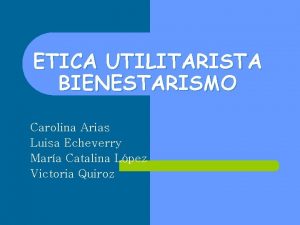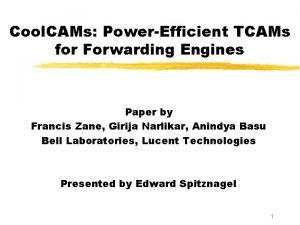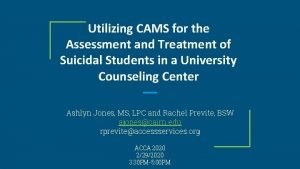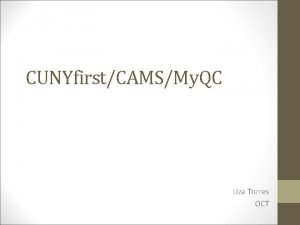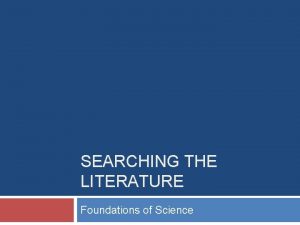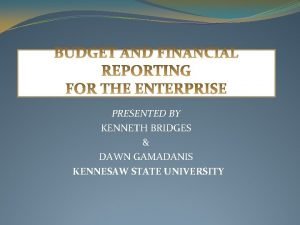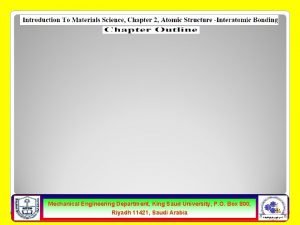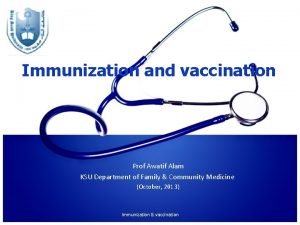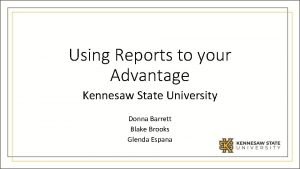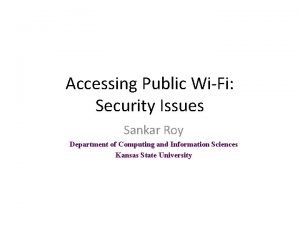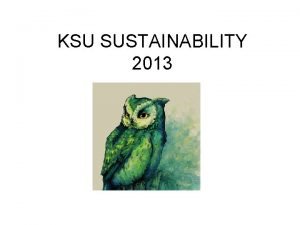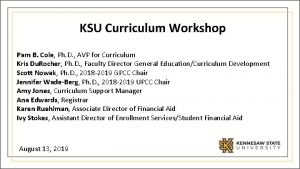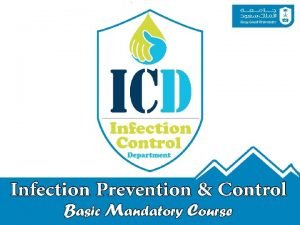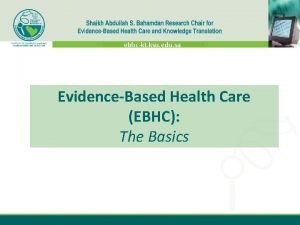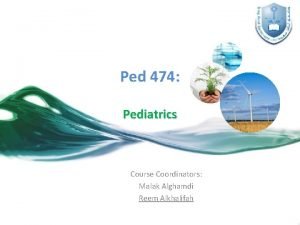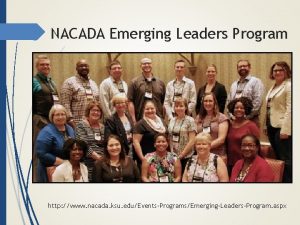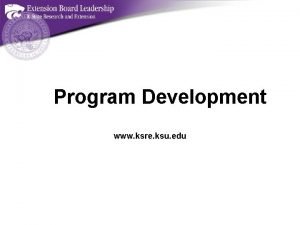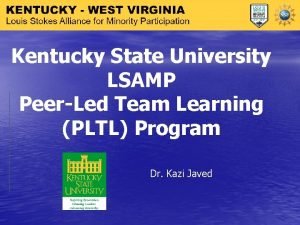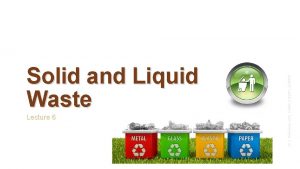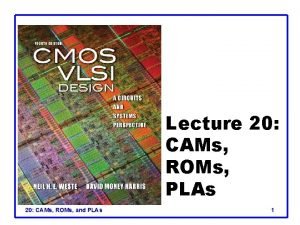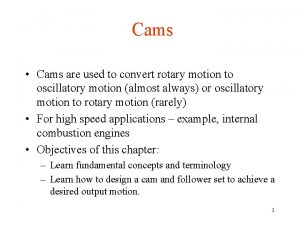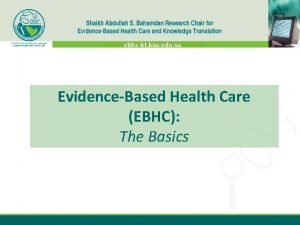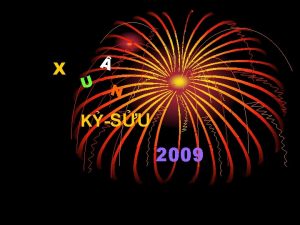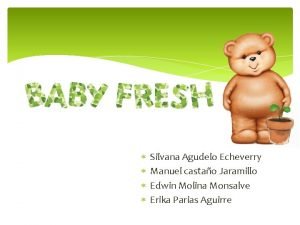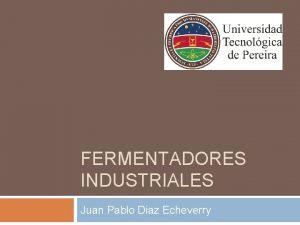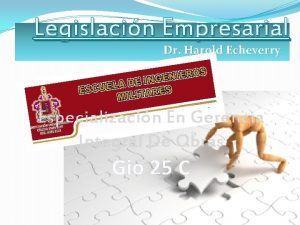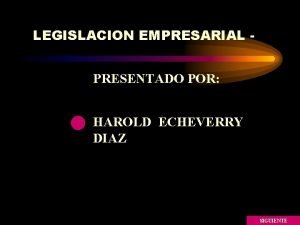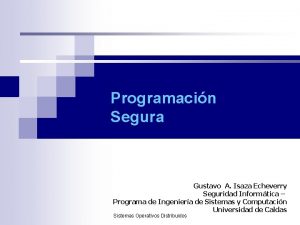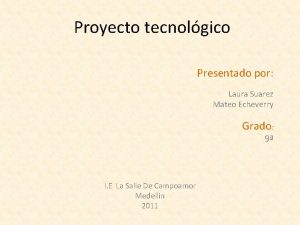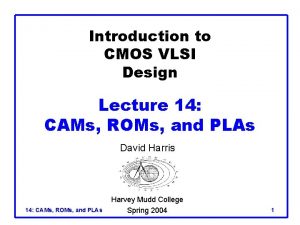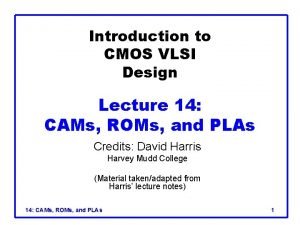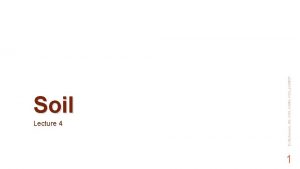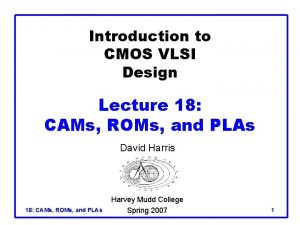WATER Lecture 3 Dr I Echeverry KSU CAMS








































- Slides: 40

WATER Lecture 3 Dr. I. Echeverry, KSU, CAMS, CHS, HE

Objectives ■ Chemical and physical properties of water. ■ Sources of water. ■ Water cycle. ■ Types and sources of water pollution. ■ Processing drinking water. ■ Environmental hazards from water pollution. Dr. I. Echeverry, KSU, CAMS, CHS, HE 2

Introduction What is water? ■ Compound made up of 2 atoms of hydrogen and one atom of oxygen (H 2 O). – Gas, liquid and solid state. ■ Essential for life on earth. – Biochemical reactions. – Water in oceans and lakes holds heat and helps to control earth’s temperature. ■ Humans may not survive more than three (3) days without water. ■ Dehydration • 2% – thirst. • 5% – fatigue, nausea, headache. • 10 -15% – muscle spasms, delirium. • > 15% – death. Dr. I. Echeverry, KSU, CAMS, CHS, HE 3

4 Dr. I. Echeverry, KSU, CAMS, CHS, HE

Introduction Water facts ■ 2/3 of earth’s surface covered by water ■ Only ~3% is fresh water – – ~ 30% of it is underground water. ~ 1% is in the atmosphere. ~0. 3% is in rivers and lakes. The rest is in the form of ice. Middlecamp CH et al. Chemistry in Context: Applying Chemistry to Society. 7 th Edition. Mc. Graw. Hill. 2012 Dr. I. Echeverry, KSU, CAMS, CHS, HE 5

Sources of water ■ Surface water – fresh water from rivers, lakes, streams. ■ Ground water – sweet water in aquifers. ■ Sea water – salty water that needs desalination before use. ■ Ice caps and glaciers – frozen water. Middlecamp CH et al. Chemistry in Context: Applying Chemistry to Society. 7 th Edition. Mc. Graw. Hill. 2012 ■ In Saudi Arabia, supplies of fossil ground water in aquifers have been rapidly depleted. ■ Desalination of sea water to convert sea water into fresh drinkable water. Dr. I. Echeverry, KSU, CAMS, CHS, HE 6

Watershed: carries water "shed" from the land after rain falls and snow melts. – Stream, lake, wetland, the ocean. ■ Supplies water for drinking, agriculture, manufacturing, recreation and the habitat to plants and animals. http: //water. epa. gov/type/watersheds/whatis. cfm What is a watershed? http: //www. nature. org/ourinitiatives/regions/northamerica/unitedstates/indiana/journeywithnature/watersheds-101. xml Dr. I. Echeverry, KSU, CAMS, CHS, HE 7

Uses of water ■ Domestic – drinking, cooking, cleaning. ■ Public use – parks, fire-fighting. ■ Agricultural – crop irrigation. ■ Recreational – lakes, rivers. ■ Industrial – energy, cooling, heating. ■ Environmental – habitat for fauna and flora. Dr. I. Echeverry, KSU, CAMS, CHS, HE 8

Water cycle https: //www. youtube. com/watch? v=9 pqh 6 tl. EOhs Dr. I. Echeverry, KSU, CAMS, CHS, HE 9

Factors affecting the water cycle Natural factors ■ A particle of water make take from a few days to thousands of years to complete the water cycle. ■ Trapped water – underground or in Trapped water glaciers. ■ Air temperature. – Changes affect the rate of water evaporation, transpiration. – Evaporation and transpiration increase with air temperature. – Needs to get back into the atmosphere. ■ Seasons – Winter and trees losing their leaves – very little transpiration. Dr. I. Echeverry, KSU, CAMS, CHS, HE 10

Factors affecting the water cycle ■ Vegetation – Environment determines the type of vegetation and the rate of transpiration. ■ Desert plants transpire little to save water. ■ Amount of sunshine – Sun provides the energy to naturally evaporate water. ■ Landscape (geography) – Run-off and percolation change with soil type a geography of terrain. – Precipitation (rain) is higher in hills and mountains than in lower areas. ■ Desert areas have a lot of sunshine and high rates of evaporation. Dr. I. Echeverry, KSU, CAMS, CHS, HE 11

Factors affecting the water cycle ■ Humidity – Amount of water vapor in the air. – Evaporation decreases when the air has high humidity. Dr. I. Echeverry, KSU, CAMS, CHS, HE 12

Factors affecting the water cycle Global climate changes ■ Affect the water cycle, environment and living organisms. – Excess rain, storms and floods and water contamination and scarcity. – Drought. – Melting glaciers. – Reduced precipitation in mountain tops, means no ice in winter, and no lakes or rivers in the summer. – Change animal patterns of migration. – Infectious diseases outbreaks. Dr. I. Echeverry, KSU, CAMS, CHS, HE 13

Water pollution ■ Presence of substances not normally found in water and that can be harmful to living organisms. – Chemical, physical, radioactive, pathogenic substances. ■ Natural or man-made. ■ Degree of pollution has to do with the quantity of pollutant in the water. ■ Following the use of water, water needs disposal, recycling, and possibly reusing. ■ Wastewater treatment/disposal and public health. ■ Natural water cycles and water purification take a long time. Dr. I. Echeverry, KSU, CAMS, CHS, HE 14

Sources of water pollution Natural and man-made Point and Non-Point Sources Dr. I. Echeverry, KSU, CAMS, CHS, HE 15

Causes of water pollution ■ Industrial and agricultural waste ■ Radioactive waste ■ Oil pollution/spills ■ Solid waste (any garbage) ■ Sewage/waste water ■ Global warming Dr. I. Echeverry, KSU, CAMS, CHS, HE 16

Types of Water Pollution Chemical pollution Sources ■ Household ■ Drugs, antibiotics dumped in sewage. ■ Cleaning chemicals. ■ Food waste. ■ Agriculture ■ Pesticides, herbicides, fertilizers ■ Radioactive materials from phosphate rock-made fertilizers. The Encyclopedia of Earth. Water pollution. http: //www. eoearth. org/view/article/156920/ Dr. I. Echeverry, KSU, CAMS, CHS, HE 17

Types of Water Pollutants Chemical pollution ■ Industrial – Runoffs, oil spills. – Heavy metals from mining. – Chemicals from manufacturing. – Radioactive materials from nuclear power plants. The Encyclopedia of Earth. Water pollution. http: //www. eoearth. org/view/article/156920/ ■ Water and sewage treatment. – Chlorinated organic molecules from sewage and water treatment. ■ Landfill (site of disposal waste). Dr. I. Echeverry, KSU, CAMS, CHS, HE 18

Types of Water Pollution Acid Rain ■ Sulfur dioxide (SO 2) and nitrogen oxides (NOx) react in the atmosphere with water, oxygen, and other chemicals to form a mild solution of sulfuric acid and nitric acid. – Natural sources – volcanoes and decaying vegetation. – Man-made sources – emissions from fossil fuel combustion. http: //www 3. epa. gov/acidrain/effects/surface_water. html ■ It includes any form of precipitation with acids. ■ Acid rain increases acidity and aluminum content in lakes and streams in a watershed. – Harm to biodiversity. – Toxic to fish and other aquatic life. 19

Types of Water Pollution Physical pollution ■ Solid debris – Vegetation, animal or human waste. – Excessive sediment (dirt) load from farming, construction, gardening. – Solid waste from human activity (plastic bags, bottles, construction). ■ Temperature changes – Heat, steam from industrial activities (point source). Three big pollutants. http: //water. epa. gov/learn/resources/bigpollutants. cfm Dr. I. Echeverry, KSU, CAMS, CHS, HE 20

Types of Water Pollution Nutrient pollution ■ Nitrogen, phosphorus. ■ Fertilizers from farms and gardens. ■ Animal waste. ■ Detergents. The Encyclopedia of Earth. Water pollution. http: //www. eoearth. org/view/article/156920/ ■ Effect on the environment – Death of aquatic life. – Interfere with water treatment. Dr. I. Echeverry, KSU, CAMS, CHS, HE 21

Types of Water Pollution Microbial pollution ■ Protozoa, bacteria, viruses, fungi. – Untreated sewage, surface runoff. – Landfill and dump runoff. – Animal waste from farms. Influenza virus Staph Aureus Hookworm Common waterborne pathogens ■ Entamoeba histolytica – protozoa. ■ Salmonella, Shigella, E. coli, Vibrio cholerae – bacteria. ■ Usually associated with fecal contamination of water. Fungi Amoeba Three big pollutants. http: //water. epa. gov/learn/resources/bigpollutants. cfm Dr. I. Echeverry, KSU, CAMS, CHS, HE 22

Water Pollution and waterborne disease ■ Transmitted by contaminated water carrying the infective agent. – Gastroenteritis – diarrhea, cramps, nausea, vomiting. ■ Life-threatening for the young, the elderly, pregnant women and the immunocompromised. ■ Amebiasis – caused by the parasite Entamoeba histolytica. – Amoeba produces cysts that are carried in feces. – intestinal infections. ■ Giardiasis and Cryptosporidiosis – caused by Cryptosporidiosis parasites in animal and human feces. – Especially at risk are the immunocompromised. ■ Diarrhea, cramps, headache. – Chlorine destroys Giardia but not Cryptosporidium. – Boiling water for >1 minute will destroy these and other pathogens. Dr. I. Echeverry, KSU, CAMS, CHS, HE 23

Water Pollution and waterborne disease ■ Legionnaire’s disease – Lung infections – pneumonia. – High fever, cough, chest pain, abdominal pain and diarrhea. – Contaminated aerosol particles from home water systems, cooling systems and stagnant water. – Some protozoa (amoebas) serve as host for the bacteria. ■ Naegleria fowleri – ‘Brain-eating’ amoeba. – Normally harmless and found in warm freshwater lakes and in soil. – Can infect the brain via the nasal passages, breaking down nerve cells. – Tap water, saline solutions. Dr. I. Echeverry, KSU, CAMS, CHS, HE 24

Water consumption ■ Maximum contaminant level goal (MCLG) – ideal situation. – Maximum level of a contaminant in drinking water at which no known or anticipated adverse effect on human health would occur. – For known carcinogens the goal is zero, because any small amount is considered a risk. ■ Maximum contaminant level (MCL) – real situation. – It is the legal limit for the concentration of a contaminant in drinking water. – Set as close as possible to the MCLG considering the practicality of it. – Most MCL are the same as MCLG, except for carcinogens. Chemistry in Context: Applying Chemistry to Society. 7 th Edition. Middlecamp C et al. . Mc. Graw. Hill. 2012 Dr. I. Echeverry, KSU, CAMS, CHS, HE 25

Water consumption Making water safe to drink ■ Whether water is safe to drink or not depends on: – What is in the water. – How much of it is in the water. – How much water someone drinks in a day. ■ Contaminants harmful to human health have legal limits according to their toxicity. ■ Some contaminants can affect liver, kidney function, or the nervous system. ■ Lead is particularly harmful to Lead children, accumulate in bone and brain, affecting brain and neural development. – Industrial waste. – Lead pipes and lead-lined tanks in water coolers. – Limits take into account the technology available for removal. Dr. I. Echeverry, KSU, CAMS, CHS, HE 26

Water consumption Contaminants regulated in drinking water ■ Inorganic chemicals – Heavy metals – copper, cadmium, chromium, mercury, lead. – Non-metal ions – nitrate, fluoride, arsenic. ■ Organic chemicals – Pesticides, solvents, and compounds for plastics manufacturing. http: //www. epa. gov/your-drinking-water/table-regulated-drinking-water-contaminants ■ Radionuclides – Alpha and beta particles, radium and uranium. ■ Biological agents – Cryptosporidium, Giardia, Legionella, fecal coliforms (E. coli) and intestinal viruses. ■ Disinfectants – Chloramines, chlorine, chlorine dioxide. ■ Disinfection byproducts – Bromate, chlorite, haloacetic acids, trihalomethanes. Dr. I. Echeverry, KSU, CAMS, CHS, HE 27

Contaminants in drinking water ■ Water disinfectants – Chloramines ■ Eye/nose irritation, stomach problems, anemia. – Chlorine ■ Eye/nose irritation, stomach problems. – Chlorine dioxide ■ Anemia, CNS problems in infants and children. Drinking Water Contaminants. http: //water. epa. gov/drink/contaminants/#List ■ Water disinfection byproducts – Bromate ■ Increased cancer risk. – Chlorite ■ Anemia and CNS problems in infants and children. – Haloacetic acids and Total triahalomethanes (TTHMs). ■ Increased cancer risk. ■ TTHMs – liver, kidney or CNS. Dr. I. Echeverry, KSU, CAMS, CHS, HE 28

Secondary drinking water contaminants ■ Non-mandatory standards established only as guidelines to assist public water systems in managing their drinking water for taste, color, and odor. – These contaminants are not considered a risk to health. ■ Problems related to secondary contaminants – Aesthetic — taste, color or odor. – Cosmetic — skin or teeth discoloration. – Technical — damage to water equipment or reduced effectiveness Contaminant Secondary MCL Aluminum Chloride Color 0. 05 to 0. 2 mg/L* 250 mg/L 15 color units Noticeable Effects above the Secondary MCL colored water salty taste visible tint Copper 1. 0 mg/L metallic taste; blue-green staining Corrosivity Non-corrosive Fluoride Foaming agents 2. 0 mg/L 0. 5 mg/L Iron 0. 3 mg/L rusty color; sediment; metallic taste; reddish or orange staining Manganese 0. 05 mg/L black to brown color; black staining; bitter metallic taste Odor 3 TON (threshold odor number) "rotten-egg", musty or chemical smell p. H 6. 5 - 8. 5 low p. H: bitter metallic taste; corrosion high p. H: slippery feel; soda taste; deposits Silver 0. 1 mg/L Sulfate 250 mg/L Total Dissolved Solids 500 mg/L (TDS) Zinc 5 mg/L metallic taste; corroded pipes/ fixtures staining tooth discoloration frothy, cloudy; bitter taste; odor skin discoloration; graying of the white part of the eye salty taste hardness; deposits; colored water; staining; salty taste metallic taste Dr. I. Echeverry, KSU, CAMS, CHS, HE 29

Treating drinking water 1. Water purification ■ Screen-removal of debris. – Plant material, garbage. ■ Coagulation and Flocculation. – Addition of aluminum sulfate and calcium hydroxide to form a gel that collects suspended dirt particles. ■ Sedimentation. – Particles settle at the bottom. ■ Filtration. – Charcoal or gravel, and sand. ■ Disinfection – Kill disease-causing microbes. ■ Additional steps – Spraying the water in the air to remove volatile compounds. – Adding fluoride. Dr. I. Echeverry, KSU, CAMS, CHS, HE 30

Treating drinking water 2. Disinfection A. Chlorine ■ Kills microorganisms by direct contact. ■ Cannot kill bacteria or viruses inside dirt particles. ■ Dirt particles must be removed before chlorination. Toxicity concerns ■ Chlorine-containing compounds that remain after disinfection. – Gases that keep the water form getting contaminated during transport. ■ Chlorine can react with organic matter in drinking water forming toxic compounds. – Trihalomethanes – chlorine, Trihalomethanes bromine. Dr. I. Echeverry, KSU, CAMS, CHS, HE 31

Treating drinking water Disinfection B. Ozone treatment Disadvantages ■ O 3 can kill bacteria when used for water disinfection. ■ Expensive to treat small amounts of water. Advantages ■ Ozone decomposes quickly and water can get contaminated during transport. ■ Smaller amounts of O 3 compared to chlorine are used. ■ More effective against viruses than chlorine. ■ Small amount of chlorine is added to ozonated water before leaving the treatment plant. Dr. I. Echeverry, KSU, CAMS, CHS, HE 32

Treating drinking water Disinfection C. Ultraviolet light ■ UV-C light that can breakdown nucleic acids and DNA in microorganisms like bacteria, viruses, molds, parasites. Disadvantages Advantages ■ Water can get contaminated after leaving the treatment plant. ■ Fast, inexpensive, can be used in a small scale. ■ It does not destroy microbes hidden inside suspended particles. – Rural homes with unsafe well water. Dr. I. Echeverry, KSU, CAMS, CHS, HE 33

Water Desalination ■ Removal of the sodium and chloride ions from the water. – Sea water has high salt content (3. 5%). ■ Reverse osmosis – membranes and pressure to separate the sodium and chlorine ions from the water. ■ Distillation – heating sea water, and condensing and collecting the vapor. – Energy-consuming process (-) – The heat purifies the water (+) Dr. I. Echeverry, KSU, CAMS, CHS, HE 34

Prevention of water pollution and waste ■ Conserve water. – Turn off the tap when running water is not necessary. – Cut down water spent on household cleaning. ■ Mind the waste that goes down the drains. ■ Reduce use of household chemicals. – Cleaning and personal use. – Pesticides and fertilizers. Dr. I. Echeverry, KSU, CAMS, CHS, HE 35

Consequences of water pollution ■ Harm to living organisms - longterm and short-term exposure. ■ Industrial waste and heavy metals – Toxic to immune system, reproductive system, liver, kidneys, developmental problems, cancer. ■ Acid rain – Harm to aquatic life. ■ Microbial pollutants from sewage. – Waterborne infectious diseases. ■ Cholera and typhoid fever. ■ Suspended particles in freshwater affect the quality of drinking water for humans and the environment for aquatic life. – Can reduce the amount of sunlight penetrating the water, disrupting the growth of photosynthetic plants and microorganisms. Dr. I. Echeverry, KSU, CAMS, CHS, HE 36

References ■ Frumkin H. Environmental Health: From Global to Local. 2 nd Ed. Jossey-BSS, Wiley Imprint. 2010. ■ Middlecamp CH et al. Chemistry in Context: Applying Chemistry to Society. 7 th Edition. Mc. Graw. Hill. 2012. ■ The Encyclopedia of Earth. Water pollution. http: //www. eoearth. org ■ The water cycle. http: //www. futuresparks. org. au/media/20852/pearson_science_7_sb_chapter_3_unit_3. 3. pdf ■ USGS. Summary of the water cycle. http: //water. usgs. gov/edu/watercyclesummary. html ■ Drinking Water Contaminants. http: //water. epa. gov/drink/contaminants/#List ■ Water: drinking water. http: //water. epa. gov/drink/ ■ Penn State Extension. Lead in drinking water. http: //extension. psu. edu/natural-resources/water/drinkingwater/water-testing/pollutants/lead-in-drinking-water Based on Lead in Drinking Water, 1994, by Bryan Swistock and William Sharpe. Updated January 2016 by Amy Galford and Bryan Swistock. Dr. I. Echeverry, KSU, CAMS, CHS, HE 37

Reading (optional) ■ http: //waterandme. tamu. edu/Water. Pollution/waterpollution. pdf Dr. I. Echeverry, KSU, CAMS, CHS, HE 38

39

Thank you! 40
 Luisa echeverry
Luisa echeverry Water and water and water water
Water and water and water water Benchmark cams
Benchmark cams Funky-cams
Funky-cams Cams a
Cams a Cams suicide assessment
Cams suicide assessment Matecam
Matecam How to use hello sign
How to use hello sign Oct stands for
Oct stands for 01:640:244 lecture notes - lecture 15: plat, idah, farad
01:640:244 lecture notes - lecture 15: plat, idah, farad Ksu supersearch
Ksu supersearch Ksu fiscal services
Ksu fiscal services Ksu mechanical engineering
Ksu mechanical engineering K state counseling services
K state counseling services Ksu counseling and psychological services
Ksu counseling and psychological services Classification of immunization
Classification of immunization Lms ksu
Lms ksu Ksu fye 1322
Ksu fye 1322 Ksu owl express
Ksu owl express Ksu.edu.ru
Ksu.edu.ru How to connect to ksu wifi
How to connect to ksu wifi Tevera ksu
Tevera ksu Ksu bob routes
Ksu bob routes Ksu.edu.tw
Ksu.edu.tw Ksu degreeworks
Ksu degreeworks Icity.ksu.edu.sa
Icity.ksu.edu.sa Ksu.edu.tw
Ksu.edu.tw Ksu.edu.tw
Ksu.edu.tw K-state computer science
K-state computer science Fac ksu
Fac ksu Www.ksu
Www.ksu Ksu cse fye
Ksu cse fye Contoh delivery order
Contoh delivery order Dxr ksu
Dxr ksu Ksre.ksu.edu
Ksre.ksu.edu Nacada emerging leaders program
Nacada emerging leaders program Ksu 選課
Ksu 選課 Httpfac
Httpfac Ksre.ksu.edu
Ksre.ksu.edu Ksu math department
Ksu math department Lsamp ksu
Lsamp ksu
